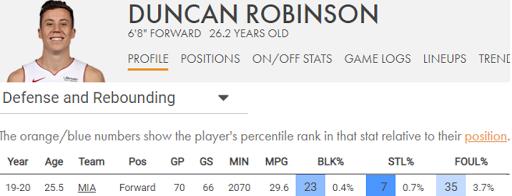Photo by Daniel A. Varela / Miami Herald
By: Khalid Leader
Duncan Robinson ascended from relative obscurity to become the third best player on a championship contender. Duncan went undrafted out of Michigan in 2018 and played most of his rookie season in the G League, appearing in only 15 NBA games. Fast forward to the 2020 season, he's now a full-time starter shooting 45% on 8 threes per game.
Great shooters come in different archetypes: the Kerr-like specialist, the Korver-like role player, and the rarefied air of the Klay-like superstar. Where does Duncan Robinson fall in this spectrum and how valuable will he be toward Miami's playoff run?
Team Impact
The Miami Heat have been a mess offensively since LeBron departed in 2014. Never ranking greater than #13th, they've had a middling offense year after year due to the lack of an efficient go-to scorer and quality 3pt shooting:
from Cleaningtheglass.com
Miami totally changed course this season, rising to the 7th ranked offense. The most significant upgrade was signing a true star in Jimmy Butler (he drove the #1 ranked FT rate shown above) while the other refinement was unleashing Duncan Robinson. Duncan was simply the best shooter in the league this year (per Kirk Goldsberry, Duncan led all players in jump shot efficiency at 66.5 eFG%).
When Duncan is on the floor, Miami's offense rises near the 2nd ranked Clippers and when he's off, they drop toward the 24th ranked T-Wolves. No other player on the Heat had larger on/off court impact. Check out the respect that defenses give Duncan, opening opportunities for his teammates to thrive:
Every team has quality shooters, but what makes Duncan a notch above most is a quick release and shot diversity. He can step into shots with a 1-2 plant or utilize a hop to gain balance and explosion on his release.
Optimal Setting
Duncan's marksmanship can add value to any team, but his ceiling is maximized on the Heat due to his chemistry with Bam Adebayo. Bam has a unique skill set where his main strengths of dribbling coordination and passing vision mix well with elite shooters.
The dribble hand-off is the foundation of Miami's offense, but when Bam and Duncan are the participants, you get one of the most efficient plays in the league. Miami is relentless with their attack, often running it multiple times on a single possession until the defense cracks:
Duncan is no longer a secret and teams have started giving him the Steph treatment, shading the high side of every screen. Duncan has improved his ability to read the defense and back cut for easy layups. He's even shooting 80% at the rim this season (albeit on low volume). Secondary drives and timely cuts will be imperative as he commands more attention in the playoffs.
Is Duncan Robinson the next Klay Thompson?
Unlikely, primarily due to his defensive limitations. Klay is a plus on-ball defender with the strength and lateral agility to guard three positions. Duncan has relatively slow feet and a knack for picking up cheap fouls defending with his hands.
from Cleaningtheglass.com
Even with those limitations, Robinson is by no means a bad defender. He fights on defense and is attentive off the ball. Miami was better defensively with him on-court, although that is mostly attributable to his minutes aligning with Jimmy and Bam. As he improves his strength, he could even play minutes at power forward, enabling greater lineup flexibility around Miami's All-Stars.
With Jimmy, Bam, promising youth, and max cap space in 2021, Miami has one of the brightest futures in the league. Duncan's salary (just $1.6M) and age (26) makes Miami's outlook even rosier. Given Bam and Jimmy's shooting limitations, Duncan is the perfect 3rd wheel. How Micky Arison and Pat Riley proceed will be fascinating, but any decision to add to the roster should prioritize keeping Duncan's talents on Biscayne Blvd for years to come.
*All stats are from Cleaningtheglass.com and NBA.com/stats






















